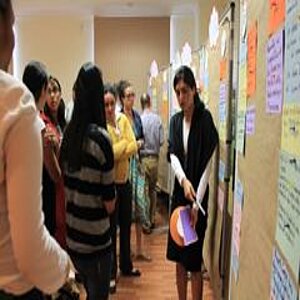Exploring mechanisms to promote High Biodiversity REDD: Piloting in Viet Nam
The project supported the Governments of Viet Nam and the Lao People's Democratic Republic in incorporating the social and environmental co-benefits of reducing emissions from deforestation and forest degradation (REDD+) into the process of introducing national REDD+ strategies. Furthermore, the project partners identified opportunities for integrating social and environmental safeguards into existing processes and practices. Incorporating REDD+ safeguards and co-benefits required the introduction and testing of innovative mechanisms in order to support - in addition to emission reductions – the sustainable social development of the local population and the protection of biological diversity. Such mechanisms included the development of subnational REDD+ implementation plans that take social and environmental criteria into account as well as the introduction of participatory forest monitoring and local profit-sharing mechanisms for REDD+.
- Countries
- Laos, Viet Nam
- IKI funding
- 2,433,635.18 €
- Duration
- 11/2010 till 11/2016
- Status
- completed
- Implementing organisation
- SNV Netherlands Development Organisation - Netherlands
- Political Partner
-
- Ministry of Agriculture and Rural Development (MARD) - Viet Nam
- Implementing Partner
-
- Ministry of Agriculture and Rural Development (MARD) - Viet Nam
State of implementation/results
- Project completed
- In Vietnam, the project had a broad and multifold impact from the national to the provincial level. Through policy advice at the national level, a Country Safeguards Roadmap was developed as part of the National REDD+ Programme and a Technical Working Group on Environmental and Social Standards was set up, in which the project leader SNV continues to hold the deputy chair after the end of the project period.
- The 3rd version of Vietnam's National Biodiversity Strategy (NBSAP) now mentions links between REDD+ and biodiversity.
- In Laos, the project equally supported the establishment of a technical working group on environmental and social standards. To this end, various trainings served for capacity building on REDD+ in general, benefits and standards in particular, and benefit sharing under REDD+.
- In the two Vietnamese pilot regions Lam Dong and Ca Mau, the project, together with USAID LEAF and UN-REDD, supported the development of provincial REDD+ action plans. Particular attention was paid to the inclusion of all stakeholder groups as well as co-benefits.
- The project’s participatory approach influenced Vietnam's national guidelines for subnational REDD+ planning processes, which are currently being applied in six other provinces (multiplier effect), and was integrated into Vietnam's National REDD+ Action Plan in connection with REDD+ monitoring.
- In the Vietnamese pilot area Lam Dong, the project developed in close cooperation with local authorities and communities an innovative methodology in three parts for forest monitoring (participatory carbon, biodiversity and social monitoring). This methodology was specifically designed for the purpose of replication in other countries.
- In addition, the project trained almost 300 people locally in data acquisition methods for biodiversity monitoring.
- Various project elements and approaches (e.g. for integrating environmental and social standards into national and sub-national REDD+ planning, participatory monitoring methods) are currently being replicated in a further ICI project ("Operationalising National Safeguard Requirements for Results-based Payments from REDD+") in Ghana and Peru, after being adapted to local conditions.
- In Vietnam, local “Multiple Benefit Incentive Models” were developed for the province of Lam Dong and could be integrated into the province's REDD+ Action Plan.
- In Laos, the project analysed options for equitable profit distribution under REDD+.
- Overall, the project has produced more than 20 knowledge products (handouts, field reports, studies), e.g. "Mapping the potential for REDD+ to deliver biodiversity conservation in Viet Nam", "Participatory Biodiversity Monitoring for REDD+ - considerations for national REDD+ programmes", "A country-led approach to REDD+ safeguards and multiple benefits". – Finally, the project participated or contributed to more than 25 international events (including COP 17 and 18 World Climate Conferences) in order to share the new knowledge and methods and thereby enrich the international REDD+ process.
Latest Update:
04/2025
Project relations
Legend:
The link has been copied to the clipboard











